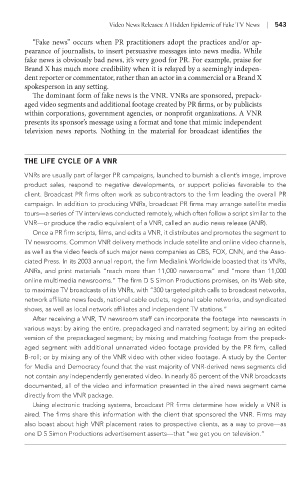Page 564 - Battleground The Media Volume 1 and 2
P. 564
V deo News Releases: A H dden Ep dem c of Fake TV News |
“Fake news” occurs when PR practitioners adopt the practices and/or ap-
pearance of journalists, to insert persuasive messages into news media. While
fake news is obviously bad news, it’s very good for PR. For example, praise for
Brand X has much more credibility when it is relayed by a seemingly indepen-
dent reporter or commentator, rather than an actor in a commercial or a Brand X
spokesperson in any setting.
The dominant form of fake news is the VNR. VNRs are sponsored, prepack-
aged video segments and additional footage created by PR firms, or by publicists
within corporations, government agencies, or nonprofit organizations. A VNR
presents its sponsor’s message using a format and tone that mimic independent
television news reports. Nothing in the material for broadcast identifies the
the liFe CyCle oF a Vnr
VNRs are usually part of larger PR campaigns, launched to burnish a client’s image, improve
product sales, respond to negative developments, or support policies favorable to the
client. Broadcast PR firms often work as subcontractors to the firm leading the overall PR
campaign. In addition to producing VNRs, broadcast PR firms may arrange satellite media
tours—a series of TV interviews conducted remotely, which often follow a script similar to the
VNR—or produce the radio equivalent of a VNR, called an audio news release (ANR).
Once a PR firm scripts, films, and edits a VNR, it distributes and promotes the segment to
TV newsrooms. Common VNR delivery methods include satellite and online video channels,
as well as the video feeds of such major news companies as CBS, FOX, CNN, and the Asso-
ciated Press. In its 2003 annual report, the firm Medialink Worldwide boasted that its VNRs,
ANRs, and print materials “reach more than 11,000 newsrooms” and “more than 11,000
online multimedia newsrooms.” The firm D S Simon Productions promises, on its Web site,
to maximize TV broadcasts of its VNRs, with “300 targeted pitch calls to broadcast networks,
network affiliate news feeds, national cable outlets, regional cable networks, and syndicated
shows, as well as local network affiliates and independent TV stations.”
After receiving a VNR, TV newsroom staff can incorporate the footage into newscasts in
various ways: by airing the entire, prepackaged and narrated segment; by airing an edited
version of the prepackaged segment; by mixing and matching footage from the prepack-
aged segment with additional unnarrated video footage provided by the PR firm, called
B-roll; or by mixing any of the VNR video with other video footage. A study by the Center
for Media and Democracy found that the vast majority of VNR-derived news segments did
not contain any independently generated video. In nearly 85 percent of the VNR broadcasts
documented, all of the video and information presented in the aired news segment came
directly from the VNR package.
Using electronic tracking systems, broadcast PR firms determine how widely a VNR is
aired. The firms share this information with the client that sponsored the VNR. Firms may
also boast about high VNR placement rates to prospective clients, as a way to prove—as
one D S Simon Productions advertisement asserts—that “we get you on television.”

